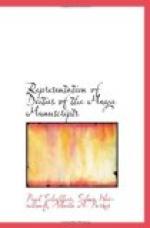The goddess is pictured in the manner described in the following places: Dr. 39b, 43b, 67a and 74. The figure corresponding to her in the Madrid manuscript, in Tro. 27 and 34*c, displays some variations, in particular the tiger claws on the feet and the red-brown color of the body are lacking. But the agreement cannot be questioned, I think, when we recall that the Maya manuscripts doubtless originated in different ages and different areas of civilization, circumstances which readily explain such variations. The goddess distinguished in the Madrid manuscript by symbols of flood and water is doubtless the same as goddess I of the Dresden manuscript described above; her unmistakable character of water-goddess in both manuscripts is in favor of this. In both manuscripts she is invariably distinguished by the serpent on her head, which, as we know, is a symbol of the water flowing along and forming waves.
Strange to say, a fixed hieroglyph of this goddess cannot be proved with certainty. There is some probability in favor of the sign given in Fig. 41. The well-known oblong signs, which Foerstemann (Drei Mayahieroglyphen, published in the Zeitschrift fuer Ethnologie, 1901, pp. 215-221) interprets as the sign for evil days, frequently occur with her. This would be appropriate for the goddess of floods.
In the Dresden manuscript a few similar figures of women are found, who, like goddess I, wear a knotted serpent on the head. Representations of this kind occur in Dr. 9c, 15b, 18a, 20a, 22b and 23b. Whether they are identical with goddess I is doubtful, since there is no symbolic reference to water in these passages. Besides, the hieroglyphs of other known deities occur each time in the above-mentioned places, so that definite mythologic relations must be assumed to exist here between the women repsented and the deities in question. Thus in Dr. 9c we find D’s sign, in 15b that of H; on 18a, 22b and 23b we see only the general sign for a woman. In Dr. 20a the signs are effaced.
In the Codex Troano goddess I occurs on pp. 25b and 27; there is also a woman with the knotted serpent on her head in Tro. 34*c. In the Codex Cortesianus and in the Paris manuscript these forms are wholly lacking.
K. The God with the Ornamented Nose.
[Illustration: Figs. 42-43]
This god, as already mentioned in connection with B, is not identical with the latter, but is probably closely related to him. His hieroglyph is Fig. 42; Fig. 43 is the form in the Madrid manuscript. He is closely related to god B. He is represented in Dr. 25 (centre) where he is perhaps conceived of as a priest wearing a mask with the face of the god, also in Dr. 7a, 12a (with his own hieroglyph and that of E!), 26 (bottom) with a variant of the sign. His figure without the hieroglyph occurs in Dr. 3. Very frequently the well-known group, 3 Oc, is given with him and in connection with his hieroglyph (in Dr. 3, 7a, 10b (right); without picture, 12a).




